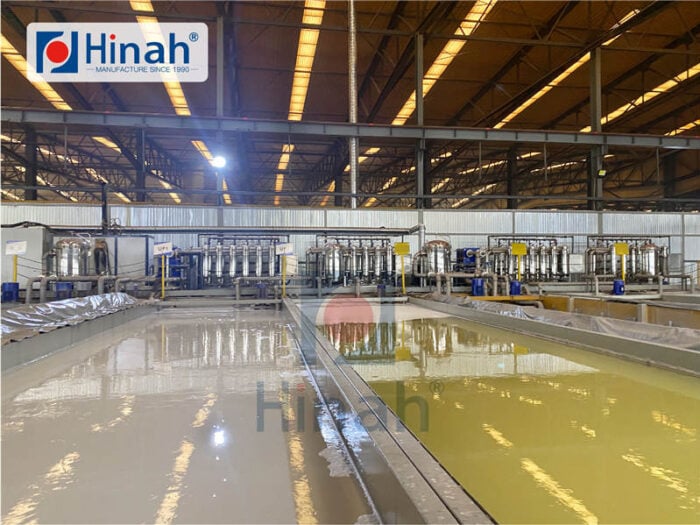5 advantages of electrophoretic coating lines VS. powder coating lines
Electrophoretic coating (E-coating) is a common coating process that has unique features and advantages over powder coating. In this article, we will discuss the characteristics and advantages of an electrophoretic coating line and compare it with a powder coating line.

I. Features of the electrophoretic coating line
1. High material utilisation rate
Electrophoretic coating can cover the surface of the workpiece evenly, thus greatly improving the utilization rate of the coating. The electrophoresis tank and recycling system in the electrophoresis coating line can recycle the paint that has not been deposited, thus minimizing the waste of paint.
2. High coating quality
Electrophoretic coating forms a dense coating on the surface of the workpiece, and the thickness, uniformity and adhesion of the coating can be effectively controlled. In addition, electrophoretic coating can form a coating inside the workpiece, thus ensuring that the internal and external surfaces of the workpiece can be perfectly protected.
3. High production efficiency
Electrophoretic coating can be applied quickly and with high production efficiency. On the electrophoretic coating line, the workpiece can be directly electrophoretically coated, eliminating the need for pre-treatment and post-treatment in powder coating, which can greatly reduce the production cycle and production costs.
4. Environmental protection and energy saving
Electrophoretic coating is an environmentally friendly and energy-saving coating process. The circulating liquid on the electrophoretic coating line can be recycled, thus reducing the production and discharge of waste liquid. In addition, electrophoretic painting can be completed at low voltage, reducing energy consumption and environmental pollution.

II. Advantages of the electrophoretic coating line
1. Good treatment effect
Electrophoretic coating can form a uniform, dense and corrosion-resistant coating on the surface of the workpiece, which can effectively protect the workpiece and prolong its service life.
2. Strong coating adhesion
Electrophoretic coating can cover the surface of the workpiece evenly, thus enhancing the adhesion of the coating to the workpiece and improving the adhesion and durability of the coating.
3. High coating efficiency
Electrophoretic coating can be applied quickly and with high production efficiency. On the electrophoretic coating line, the workpiece can be directly electrophoretically coated, eliminating the need for pre-treatment and post-treatment in powder coating, which can greatly shorten the production cycle and production costs and improve production efficiency and production benefits.
4. Strong applicability
Electrophoretic coating can be applied to the surface coating of various materials, including metal, plastic, wood, etc. In addition, electrophoretic painting can form a coating on the inside of the workpiece, thus ensuring that both the inside and outside surfaces of the workpiece can be perfectly protected.
5. Environmental protection and energy saving
Electrophoretic coating is an environmentally friendly and energy-saving coating process. The recycled liquid on the electrophoretic coating line can be recycled, thus reducing the production and discharge of waste liquid. In addition, electrophoretic painting can be completed under low voltage, reducing energy consumption and environmental pollution.

Comparison of electrophoretic coating line and powder coating line
1. Different process principles
Electrophoretic coating is a kind of electrostatic coating technology, using the interaction between the electric charge on the surface of the workpiece and the electric charge of the paint particles to achieve the coating. Powder coating, on the other hand, is a mechanical coating technology that uses a high-speed spraying device to spray powder coating onto the surface of the workpiece.
2. Different coating effects
Electrophoretic coating can form a uniform, dense, corrosion-resistant coating on the surface of the workpiece, and the thickness, uniformity and adhesion of the coating can be effectively controlled. The quality of powder coating is influenced by many factors, such as ambient temperature, humidity, coating thickness and coating speed.
3. Different coating speed
Electrophoretic coating can be applied quickly and with high production efficiency. On the electrophoretic coating line, the workpiece can be painted directly by electrophoresis, eliminating the need for pre-treatment and post-treatment in powder coating, which can greatly reduce the production cycle and production costs. In contrast, powder coating requires pre-treatment and post-treatment, and the production cycle and production costs are relatively high.
4. Different scope of application
Electrophoretic coating can be applied to the surface of various materials, including metal, plastic, wood, etc. Powder coating, on the other hand, is more applicable to the surface coating of metal materials and is less effective for non-metal materials.
In summary, the electrophoresis coating line has the advantages of high material utilisation rate, high coating quality, high production efficiency, environmental protection and energy saving, etc., and is applicable to a wide range of applications. Compared with powder coating lines, electrophoretic coating lines have the advantages of more stable and reliable coating quality, higher production efficiency and a wider coating range. However, when choosing the coating process, comprehensive consideration is needed according to the specific product requirements, production costs and coating cycle, etc.

III. Summary
Electrophoresis coating line is an electrostatic coating technology with the advantages of high material utilisation, high coating quality, high production efficiency, environmental protection and energy saving. Compared with powder coating lines, electrophoretic coating lines have the advantages of more stable and reliable coating quality, higher production efficiency and wider coating range. In actual production, it is necessary to make comprehensive consideration according to the specific product requirements, production cost and coating cycle, etc. to choose the suitable coating process in order to improve production efficiency, reduce production cost and ensure product quality.






